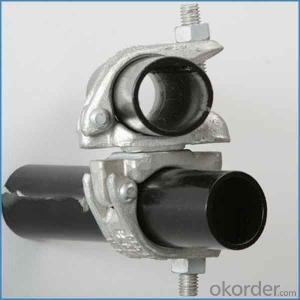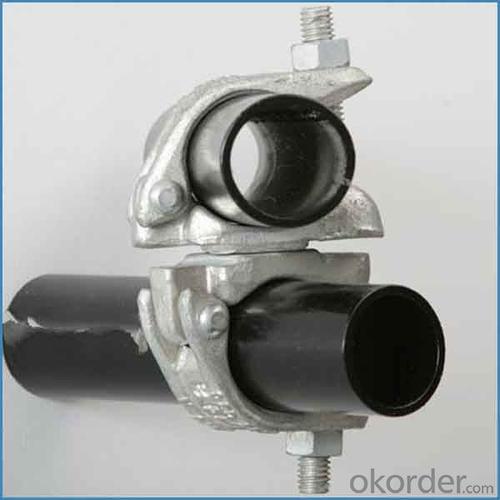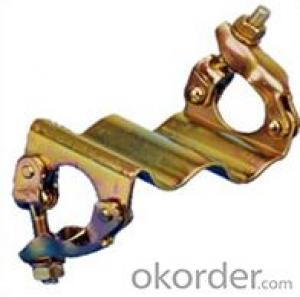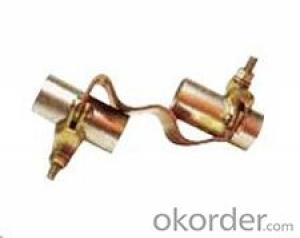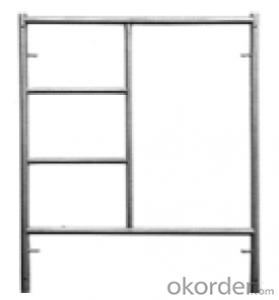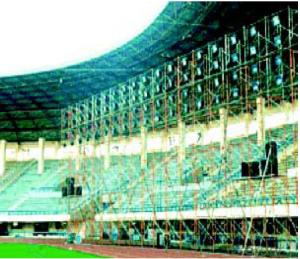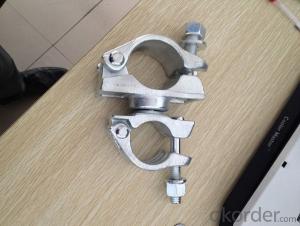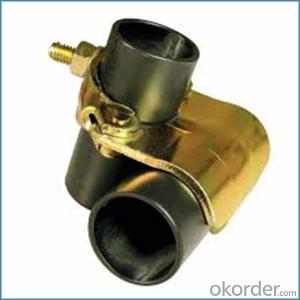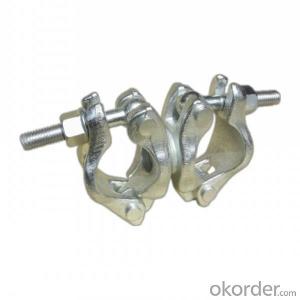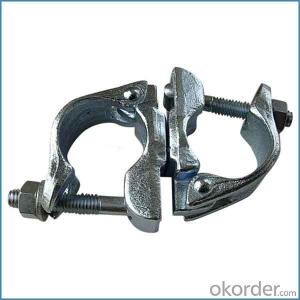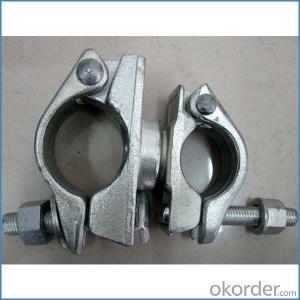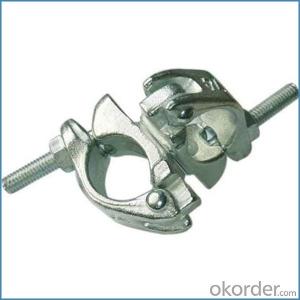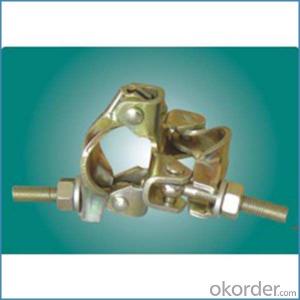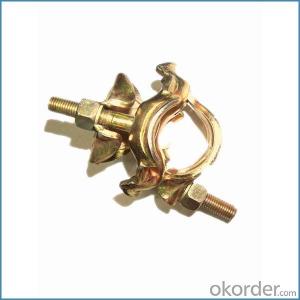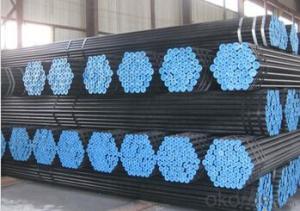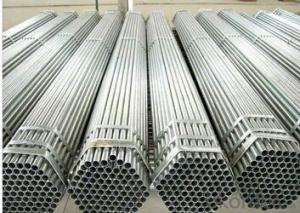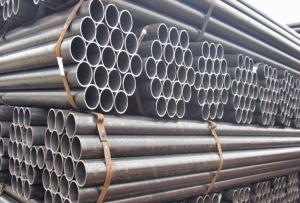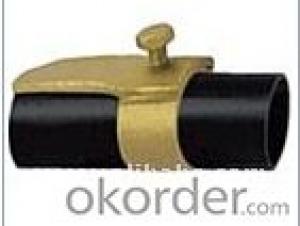Type for Sales Of Couplers British Type for Sale
- Loading Port:
- Tianjin
- Payment Terms:
- TT OR LC
- Min Order Qty:
- 1000 kg
- Supply Capability:
- 100000 kg/month
OKorder Service Pledge
OKorder Financial Service
You Might Also Like
Type for Sales Of Couplers British Type for Sale
Description
1.The scaffolding coupler is always used to connect the steel pipe as scaffolding system.
2.The often used coupler is swivel coupler and righ angle coupler .
3.We can provide types of scaffolding coupler according to your requirement.
4.Couoler can fix the 48.3mm scaffolding steel pipe tightly and make the whole scaffolding system more steadily.
5.Material:Q235 steel
6.Overall Size:48.3mm*48.3mm
7.Surface Finish: Galvanized/ Painted
8.Standard:BS1139,EN74
9.Package:25pcs/bag
10.Manufactuering as per customer requirements
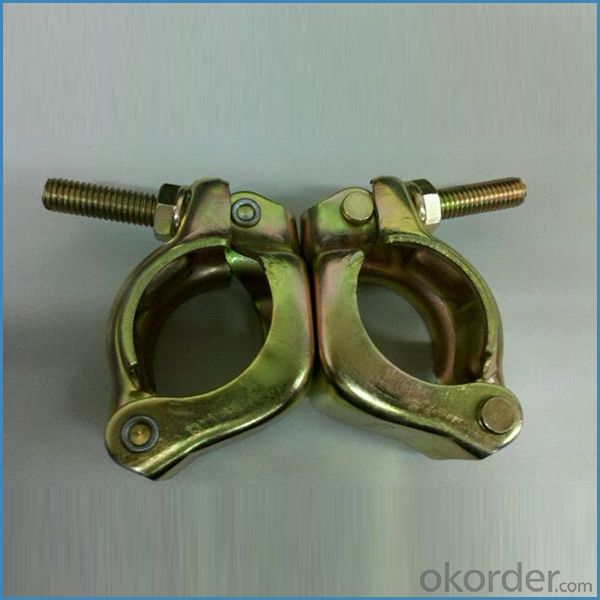
Feature
(1)Excellent Anti-Breaking—Cold Pressed Steel
(2)Outstanding Resistance Deformation
(3)Strong Anti-Dropping Ability
(4)Longtime USe
(5)Qualtity Guaranteed
(6)OEM Service
Photo
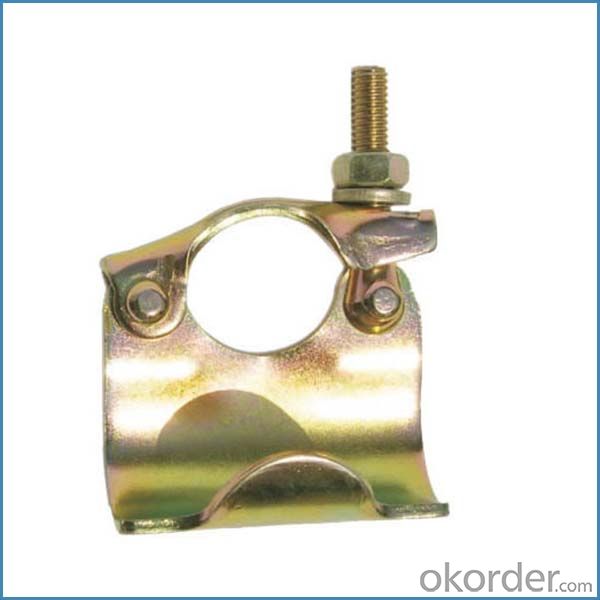
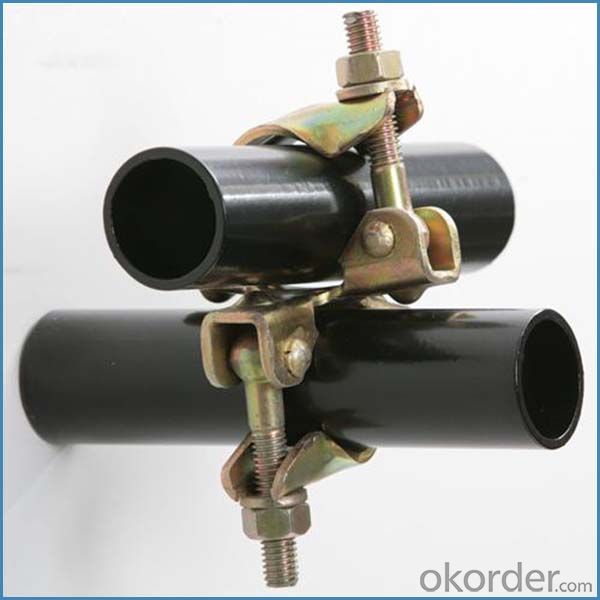
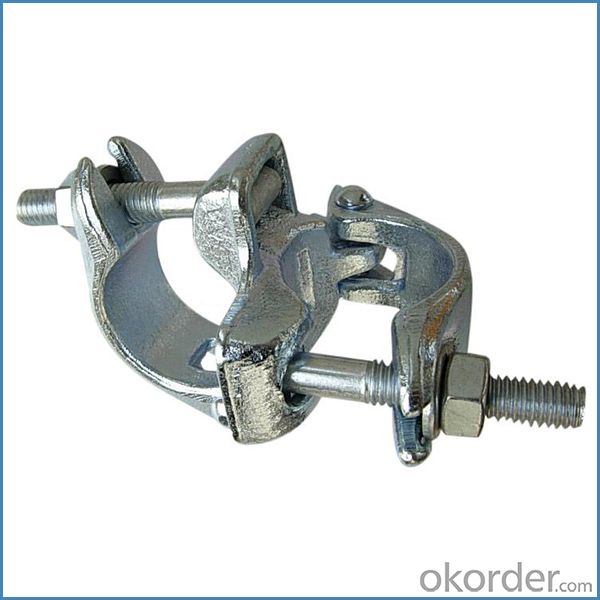
Parameter
| Material | Q235,345steel |
| Size | 48.3mm*48.3mm |
| Surface finish | Galvanized |
| Weight | 1.1kg around |
| Standard | BS1139,EN74 |
| Package | 25pcs/bag,steel pallet |
| Manufacture | As per customer requirement |
| Market | Africa, South America, the Middle East and Asia |
FAQ
Q: Are you a factory or trading company?
We are a state-owned corporation in China,dealing with various kinds of building materials.We have our holding subsidiaries.
Q: Where is your factory located? How can I visit there?
Our factory is located all around China.
Q: Can I get some samples?
Sample is free, customer only pay freight for the first time.
Q: Delivery?
10-30days. (5-15 containers)
Any question,feel free to contact us.
- Q: Do you think it looks thuggy or trashy? I am not a fan of it and my 18 year old did this, I just found out!
- Personally I like how both look. It's now far more common for teenagers to get piercings like these. It's just the current trend, and because it's so common it is not regarded as a bad thing. They can actually look quite classy!
- Q: Are there any specific guidelines for the safe dismantling of scaffolding structures with steel tube couplers?
- Yes, there are specific guidelines for the safe dismantling of scaffolding structures with steel tube couplers. These guidelines typically include proper planning and risk assessment before starting the dismantling process, ensuring the stability of the scaffold during dismantling, using appropriate tools and equipment for disassembly, following a systematic and controlled dismantling sequence, and ensuring the safety of workers involved by providing adequate training and supervision.
- Q: What type of scaffolding is used in high-rise building construction?
- Generally, Φ48 × 3.5 steel pipe shall comply with the existing national standard "straight seam welded steel pipe" (GB / T) or "low pressure fluid delivery welded steel pipe" (GB / T3092) specified in the No. 3 ordinary steel, its quality should be consistent The current national standard "carbon structural steel" (GB / T700) in the provisions of Q235-A grade steel. Fasteners are made of malleable cast iron standard parts, the material should be consistent with the current national standard "steel scaffold fastener" (GB) requirements. The accessories (T-bolts, nuts, washers) of the fasteners are made of material in accordance with the requirements of Q235-A grade steel in "carbon structural steel" (GB / T700)
- Q: How do steel tube couplers ensure the proper alignment of scaffolding tubes?
- The alignment of scaffolding tubes is ensured by the use of steel tube couplers, which securely connect the tubes together. These couplers are designed to fit over the ends of the tubes, creating a connection that is both strong and rigid. Typically constructed from high-quality steel, these couplers offer durability and reliability. One important feature of steel tube couplers is their ability to maintain the alignment of the scaffolding tubes. When properly tightened, the couplers securely hold the tubes in place, preventing any movement or rotation. This ensures that the scaffolding structure remains stable and safe for workers. In addition, steel tube couplers are designed with precision and accuracy in mind. They have a snug fit that minimizes any gaps between the tubes, which is crucial for maintaining the proper alignment. This ensures that the scaffolding structure remains level and even. Furthermore, steel tube couplers are often equipped with locking mechanisms or bolts that provide additional security for the connection between the tubes. These mechanisms prevent any accidental dislodging or loosening of the couplers, which could compromise the alignment of the scaffolding. Overall, steel tube couplers play a critical role in maintaining the proper alignment of scaffolding tubes. They create a strong and secure connection that minimizes any movement or rotation. With their precise fit and locking mechanisms, they contribute to the stability and safety of the scaffolding structure.
- Q: Can steel tube couplers be used in scaffolding structures with uneven or sloped surfaces?
- Steel tube couplers can be used in scaffolding structures with uneven or sloped surfaces. These couplers are designed to provide a strong and secure connection between steel tubes, allowing for flexibility and adjustability in various construction environments. They can adapt to different angles and uneven surfaces, ensuring stability and safety in scaffolding structures.
- Q: Do steel tube couplers require any specific maintenance procedures for long-term durability?
- Specific maintenance procedures are required for long-term durability of steel tube couplers. It is essential to regularly inspect and maintain them to ensure proper functioning and longevity. Here are some recommended maintenance procedures: 1. Conduct regular visual inspections to check for wear, corrosion, or damage. Look for cracks, deformation, or misalignment, especially in areas prone to stress and strain like threaded connections or load-bearing areas. 2. Apply a suitable lubricant to the threaded connections of the couplers. This reduces friction, prevents corrosion, and facilitates easy assembly and disassembly. Follow the manufacturer's recommendations for lubrication type and frequency. 3. Clean the couplers by removing dirt, debris, or foreign particles. Use a soft brush or compressed air to avoid scratching or damaging the surface. 4. Prevent corrosion by applying a protective coating such as paint or anti-corrosion treatment. Regularly check for signs of corrosion and take immediate action to prevent further damage. 5. Store the couplers in a dry and clean environment when not in use. Protect them from moisture, chemicals, or extreme temperatures that can accelerate corrosion or cause deformation. 6. Ensure personnel responsible for handling and maintaining the couplers are properly trained and educated. They should be familiar with manufacturer's instructions, safety guidelines, and best maintenance practices. By following these maintenance procedures, you can ensure the long-term durability and reliability of steel tube couplers, minimizing the risk of failure and maximizing their lifespan.
- Q: Are steel tube couplers resistant to twisting or torsional forces in scaffolding structures?
- Yes, steel tube couplers are generally resistant to twisting or torsional forces in scaffolding structures. The strong and rigid nature of steel makes it capable of withstanding torsional loads, ensuring the stability and safety of the scaffolding system.
- Q: How do you remove steel tube couplers from scaffolding tubes?
- To remove steel tube couplers from scaffolding tubes, you can follow these steps: 1. Ensure the scaffolding is stable and secure before starting the removal process. Safety should always be the top priority. 2. Use a pipe wrench or a spanner that fits the size of the coupler. This will provide a good grip and leverage to loosen the coupler. 3. Position the wrench or spanner on the coupler and turn it counterclockwise. Apply steady pressure while turning to loosen the coupler from the tube. 4. If the coupler is tightly secured, you can use a hammer and a chisel to gently tap the coupler in a counterclockwise direction. This will help loosen it before using the wrench or spanner. 5. Once the coupler starts to loosen, continue turning it counterclockwise until it is completely removed from the scaffolding tube. 6. Repeat the process for each coupler that needs to be removed. It is important to note that if the coupler is rusted or corroded, it may be more difficult to remove. In such cases, applying a rust penetrant or lubricant a few hours before attempting to remove the coupler can help ease the process. Additionally, it is always recommended to use appropriate personal protective equipment (PPE) such as gloves and safety glasses while working with scaffolding and tools.
- Q: Can steel tube couplers be used for scaffolding projects with multiple levels and platforms?
- Yes, steel tube couplers can be used for scaffolding projects with multiple levels and platforms. Steel tube couplers are designed to connect scaffolding tubes securely, allowing for the construction of a stable and reliable scaffold structure. These couplers can be used to create strong connections between vertical and horizontal tubes, creating a safe and stable framework for multiple levels and platforms. The use of steel tube couplers ensures that the scaffold structure can support the weight of workers, equipment, and materials at various heights, providing a secure working platform for construction projects with multiple levels.
- Q: How do steel tube couplers affect the overall cost of scaffolding projects?
- Steel tube couplers can have a significant impact on the overall cost of scaffolding projects. These couplers are essential components that connect the steel tubes, forming a sturdy and reliable structure. The cost of steel tube couplers can vary depending on factors such as the type and quality of the couplers, the quantity needed, and the supplier. One aspect that affects the cost is the type of steel tube couplers used. There are various types available, including swivel couplers, sleeve couplers, putlog couplers, and beam clamps. Each type has its own specifications, applications, and cost. For example, swivel couplers are typically more expensive than sleeve couplers due to their added flexibility and adjustable features. The quality of the steel tube couplers also plays a role in the overall cost. High-quality couplers are typically more expensive but offer better durability, strength, and resistance to corrosion. Investing in superior quality couplers can lead to longer-lasting scaffolding structures, reducing the need for frequent replacements and maintenance, thus potentially lowering overall costs in the long run. The quantity of steel tube couplers needed for a particular project directly affects the cost. Large-scale projects that require a significant amount of scaffolding will naturally require a greater number of couplers, resulting in higher costs. It is essential to accurately estimate the quantity needed to avoid over-purchasing and unnecessary expenses. Lastly, the choice of supplier can impact the cost of steel tube couplers. Different suppliers may offer varying prices for identical or similar products. It is crucial to research and compare prices from multiple suppliers to ensure that the best value for money is obtained. Overall, steel tube couplers can significantly affect the cost of scaffolding projects. Factors such as the type, quality, quantity, and supplier of the couplers should be carefully considered to optimize costs while maintaining the required safety and reliability of the scaffolding structure.
Send your message to us
Type for Sales Of Couplers British Type for Sale
- Loading Port:
- Tianjin
- Payment Terms:
- TT OR LC
- Min Order Qty:
- 1000 kg
- Supply Capability:
- 100000 kg/month
OKorder Service Pledge
OKorder Financial Service
Similar products
Hot products
Hot Searches
